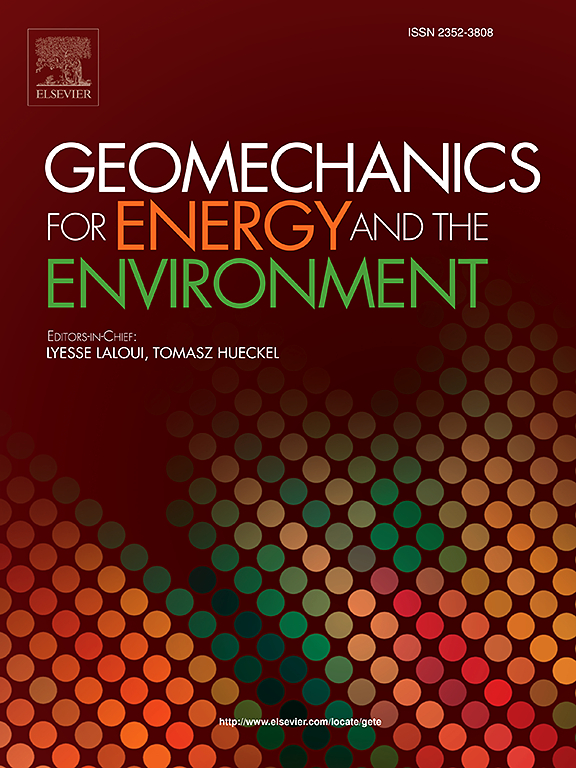单轴应力与爆炸共同作用下岩石破坏特性研究
IF 3.7
2区 工程技术
Q3 ENERGY & FUELS
引用次数: 0
摘要
爆破技术在深部岩体工程中应用广泛,爆破引起的围岩破坏和裂纹扩展通常受到地应力的影响。全面研究了单轴应力和爆破荷载共同作用下钻孔围岩裂纹的破坏和扩展规律。从数值模拟和现场工程的角度,利用爆炸试验、力学分析和有限元建模来验证这些结果。利用LS-DYNA数值软件对爆炸实验进行验证,并利用修正后的本构模型模拟不同单轴应力对岩石松动及聚能爆破破坏特性的影响。利用ImageJ软件对裂缝网络进行处理,分析岩石表面裂缝形态和分形特征。然后,利用弹性力学分析了单轴应力诱导聚能爆破破裂模式的变化,探讨了定向裂纹扩展的机理。结果表明:在松动爆破过程中,裂纹沿孔周围最大拉应力区萌生;施加单轴应力可以抑制裂纹扩展的速度和长度,控制径向裂纹扩展的方向,使裂纹平行于应力方向扩展更为有利。在聚能爆破过程中,随着单轴应力的增大,聚能方向的损伤逐渐形成完整的破坏面,显著抑制了非聚能方向的裂纹扩展。这导致裂缝减少,但扩展速度加快,裂缝和岩石损伤的分形维数减少。最后进行了聚能爆破切顶卸压试验,取得了满意的效果。在深部岩体工程中,建议采用各向异性地应力作用下的聚能爆破实现定向爆破,以更好地保持围岩的完整性,获得更光滑的爆破面。本文章由计算机程序翻译,如有差异,请以英文原文为准。
Research on rock failure characteristics under combined action of uniaxial stress and explosion
Blasting technology is widely used in deep rock mass engineering, and the surrounding rock damage and crack propagation caused by blasting are usually affected by ground stress. The failure and propagation of cracks in boreholes surrounding rock under the combined action of uniaxial stress and blasting load are comprehensively studied. Explosion tests, mechanical analysis, and finite element modeling are used to verify these results from the perspectives of numerical simulation and field engineering. The LS-DYNA numerical software is used to verify the explosion experiment, and the corrected constitutive model is used to simulate the effects of different uniaxial stresses on rock loosening and shaped charge blasting failure characteristics. The fracture network is processed by ImageJ software, and the fracture morphology and fractal characteristics of rock surface are analyzed. Then, the change of fracture mode of uniaxial stress-induced shaped charge blasting is analyzed by means of elastic mechanics, and the mechanism of directional crack propagation is discussed. The results show that the crack initiation occurs along the zone of maximum tensile stress around the hole during loosening blasting. The application of uniaxial stress can restrain the speed and length of crack growth and control the direction of radial crack growth, which makes the crack propagation parallel to the stress direction more advantageous. In the process of shaped charge blasting, with the increase of uniaxial stress, the damage in the shaped charge direction gradually forms a complete failure plane, which significantly inhibits the crack growth in the non-shaped charge direction. This leads to fewer cracks, but faster spreads, and fewer fractal dimensions of cracks and rock damage. Finally, the test of cutting the top and relieving pressure of coalmine by shaped charge blasting has been carried out, and satisfactory results have been obtained. In deep rock mass engineering, it is suggested to use shaped charge blasting under anisotropic ground stress to achieve directional blasting so as to better maintain the integrity of surrounding rock and obtain a smoother blasting surface.
求助全文
通过发布文献求助,成功后即可免费获取论文全文。
去求助
来源期刊

Geomechanics for Energy and the Environment
Earth and Planetary Sciences-Geotechnical Engineering and Engineering Geology
CiteScore
5.90
自引率
11.80%
发文量
87
期刊介绍:
The aim of the Journal is to publish research results of the highest quality and of lasting importance on the subject of geomechanics, with the focus on applications to geological energy production and storage, and the interaction of soils and rocks with the natural and engineered environment. Special attention is given to concepts and developments of new energy geotechnologies that comprise intrinsic mechanisms protecting the environment against a potential engineering induced damage, hence warranting sustainable usage of energy resources.
The scope of the journal is broad, including fundamental concepts in geomechanics and mechanics of porous media, the experiments and analysis of novel phenomena and applications. Of special interest are issues resulting from coupling of particular physics, chemistry and biology of external forcings, as well as of pore fluid/gas and minerals to the solid mechanics of the medium skeleton and pore fluid mechanics. The multi-scale and inter-scale interactions between the phenomena and the behavior representations are also of particular interest. Contributions to general theoretical approach to these issues, but of potential reference to geomechanics in its context of energy and the environment are also most welcome.
 求助内容:
求助内容: 应助结果提醒方式:
应助结果提醒方式:


